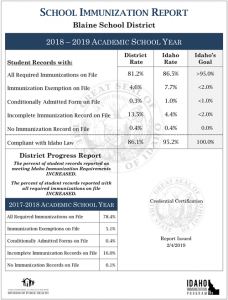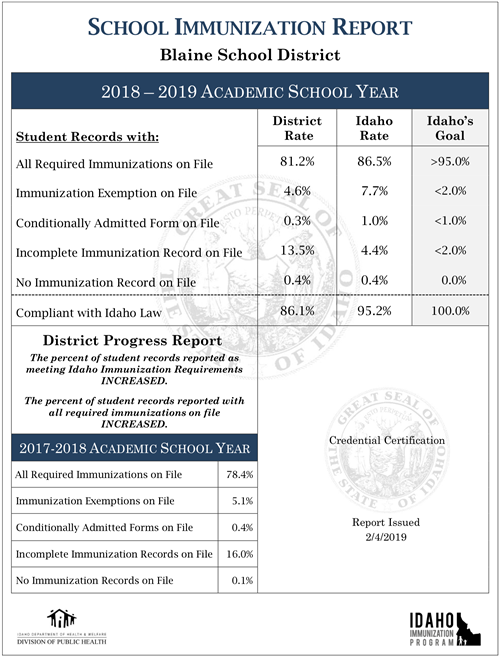82% of Blaine County kids are fully vaccinated
By Eric Valentine

Report cards came out last week, but they weren’t directed to students. These came from the state and they evaluated efforts by school districts across Idaho to get 95 percent of students fully vaccinated. The Idaho Department of Health and Welfare gave Blaine County School District a B-.
Letter grades were not specifically used in the report, but state data shows that only 81.2 percent of students in the district are fully immunized and fully recorded—13 percent off the mark of the state’s goal and more than 5 percent off the state average. Superintendent of Public Instruction Sherri Ybarra penned a letter to the school district regarding the reporting program and reminding them that Idaho law allows them to exclude students from school activities if they do not have proof of immunization.
“If fewer than 94 percent of your students are immunized, some of them could be at risk of contracting potentially serious diseases,” Ybarra wrote.
The 94 and 95 percent marks are derived from an idea called “herd immunity.” Specifically, health authorities say that if vaccination rates in a population are 94 percent or more, outbreaks of certain contagious diseases will be prevented. Other diseases, such as polio, are less contagious and only need to hit an 80 percent mark or better.
The school district lauded its recent efforts, since its current 81.2 percent trumps last year’s 78.4 percent and betters the 2013-14 school year score of 65.7 percent.
“We’re making progress!” the school district newsletter read.
With the recent outbreak of measles around the nation, including a large-scale one in nearby Washington State, scrutiny is being placed on parents who choose not to immunize their children. From social media opinion to medical doctors on TV, it’s not hard to find someone blaming the outbreaks on so-called anti-vaxxers—people who do not believe that vaccination is necessary to prevent disease and/or believe that the way vaccines are produced and administered can cause far more harm than good.
“The people making the decision not to vaccinate their kids are well informed, and more informed than the average person and even most doctors,” said parent and anti-vaccine advocate Leslie Manookian.
In 2011, Manookian produced a documentary on the subject called “A Greater Good.” And she has chosen the no-vaccine policy for her family, including when it comes to measles. Manookian said she encourages, and wants to be part of, public debate on the matter.
“With respect to measles, I do not fear my child would catch the disease,” Manookian said. “In fact, I would welcome it as we are well nourished and measles is not a dangerous disease in well-nourished people. Those who are deficient in vitamin A are known to suffer complications from measles, such as brain inflammation, but this is due to the underlying nutritional status of the individual, not the disease per se.”
Idaho law allows parents to object to immunization on religious or other grounds. However, with government health institutions holding firm on the need for vaccines, the district will have to convince the 4.6 percent of families like the Manookians to reconsider. Across the state, 7.7 percent of families opt out of the vaccine protocol. The state goal is to have only 2 percent of children unvaccinated.



